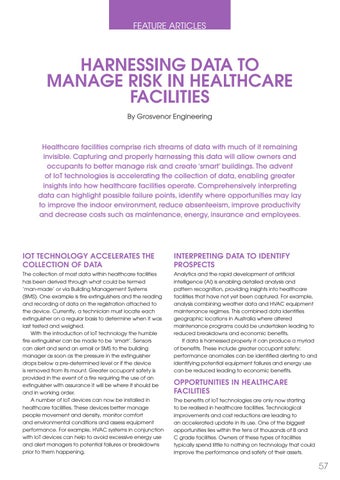FEATURE ARTICLES
HARNESSING DATA TO MANAGE RISK IN HEALTHCARE FACILITIES By Grosvenor Engineering
Healthcare facilities comprise rich streams of data with much of it remaining invisible. Capturing and properly harnessing this data will allow owners and occupants to better manage risk and create ‘smart’ buildings. The advent of IoT technologies is accelerating the collection of data, enabling greater insights into how healthcare facilities operate. Comprehensively interpreting data can highlight possible failure points, identify where opportunities may lay to improve the indoor environment, reduce absenteeism, improve productivity and decrease costs such as maintenance, energy, insurance and employees.
IOT TECHNOLOGY ACCELERATES THE COLLECTION OF DATA
INTERPRETING DATA TO IDENTIFY PROSPECTS
The collection of most data within healthcare facilities has been derived through what could be termed ‘man-made’ or via Building Management Systems (BMS). One example is fire extinguishers and the reading and recording of data on the registration attached to the device. Currently, a technician must locate each extinguisher on a regular basis to determine when it was last tested and weighed. With the introduction of IoT technology the humble fire extinguisher can be made to be ‘smart’. Sensors can alert and send an email or SMS to the building manager as soon as the pressure in the extinguisher drops below a pre-determined level or if the device is removed from its mount. Greater occupant safety is provided in the event of a fire requiring the use of an extinguisher with assurance it will be where it should be and in working order. A number of IoT devices can now be installed in healthcare facilities. These devices better manage people movement and density, monitor comfort and environmental conditions and assess equipment performance. For example, HVAC systems in conjunction with IoT devices can help to avoid excessive energy use and alert managers to potential failures or breakdowns prior to them happening.
Analytics and the rapid development of artificial intelligence (AI) is enabling detailed analysis and pattern recognition, providing insights into healthcare facilities that have not yet been captured. For example, analysis combining weather data and HVAC equipment maintenance regimes. This combined data identifies geographic locations in Australia where altered maintenance programs could be undertaken leading to reduced breakdowns and economic benefits. If data is harnessed properly it can produce a myriad of benefits. These include greater occupant safety; performance anomalies can be identified alerting to and identifying potential equipment failures and energy use can be reduced leading to economic benefits.
OPPORTUNITIES IN HEALTHCARE FACILITIES The benefits of IoT technologies are only now starting to be realised in healthcare facilities. Technological improvements and cost reductions are leading to an accelerated update in its use. One of the biggest opportunities lies within the tens of thousands of B and C grade facilities. Owners of these types of facilities typically spend little to nothing on technology that could improve the performance and safety of their assets.
57














